The natural synthetic cytokinin (anti-zeatin riboside) market is expected to expand from USD 95.6 million in 2021 to USD 143.7 million in 2025, showing a steady YoY growth trajectory. Early years exhibit gradual increases, beginning at USD 103.7 million in 2022, rising to USD 112.5 million in 2023, USD 122.1 million in 2024, and reaching USD 132.4 million in 2025. This consistent growth is driven by greater adoption in agriculture, where anti-zeatin riboside is used to enhance plant growth, improve stress resilience, and optimize crop yields. Innovations in synthetic biotechnology have also helped streamline production, boosting demand in high-value crop segments.
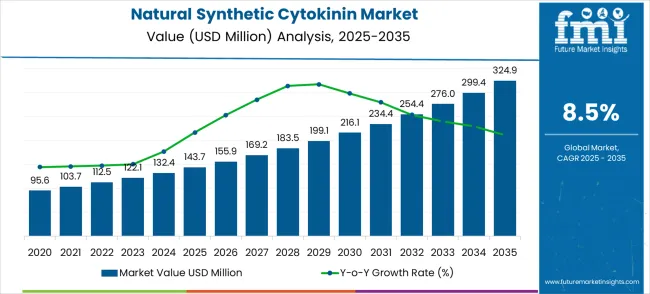
Between 2026 and 2030, the market experiences accelerated growth, advancing from USD 143.7 million in 2025 to USD 199.1 million in 2029. Annual increments include USD 155.9 million in 2026, USD 169.2 million in 2027, USD 183.5 million in 2028, and USD 199.1 million in 2029. This phase witnesses greater adoption across emerging markets, spurred by the rising focus on green farming practices and food security concerns. By 2035, the market is set to reach USD 324.9 million, maintaining an upward trajectory, supported by continued innovations in crop enhancement technologies and growing global demand for eco-friendly agricultural solutions.
| Metric | Value |
|---|---|
| Market Value (2025) | USD 143.7 million |
| Market Forecast Value (2035) | USD 324.9 million |
| Forecast CAGR (2025–2035) | 8.5% |
The agricultural chemicals market is the dominant driver, accounting for approximately 35–40% of the market share. Cytokinin-based products like Anti-zeatin Riboside are widely used to enhance crop yields, improve stress tolerance, and increase fruit and flower sizes.The plant growth regulators market, which contributes around 20–25%, plays a vital role in the demand for Anti-zeatin Riboside. These products are essential in crop management, helping to regulate plant growth and development, especially under challenging environmental conditions. The biotechnology market, responsible for about 15–18%, is another significant influence. Advances in biotechnology and plant tissue culture are crucial for the production and application of synthetic cytokinins, thus driving the demand for Anti-zeatin Riboside in genetically modified organisms (GMOs) and other biotechnological applications.
The horticulture and landscaping market, contributing about 10–12%, also plays a key role. Anti-zeatin Riboside is used in horticultural practices to promote flowering, fruiting, and overall plant health in greenhouses, nurseries, and landscaping projects. Finally, the pharmaceutical and nutraceutical market, with a share of 5–8%, is gradually emerging as a promising application space for cytokinin-based products. These products are being researched for their potential anti-aging properties and cell regeneration capabilities, expanding their use beyond agriculture into health and wellness applications. Section 3
Market expansion is being supported by the increasing plant biotechnology research activities across global academic and research institutions and the corresponding need for high-purity cytokinin compounds that enable reproducible research outcomes and breakthrough discoveries in plant science. Modern plant biology research requires exceptionally pure and well-characterized cytokinin compounds that provide consistent biological activity while supporting diverse experimental applications and regulatory compliance. The excellent purity and biological activity characteristics of natural synthetic cytokinin make it an essential component in demanding research environments where reproducibility and scientific rigor are paramount.
The growing focus on green agriculture and crop improvement is driving demand for advanced plant growth regulators from certified suppliers with proven track records of product quality and consistency. Research institutions are increasingly investing in premium-grade cytokinin compounds that offer superior purity and reliable biological activity over conventional plant hormones. Scientific standards and regulatory requirements are establishing quality benchmarks that favor precisely characterized cytokinin solutions with comprehensive analytical documentation and proven research applications.
The market is segmented by purity level, application, and region. By product purity, the market is divided into purity >97% and purity ≤97% formulations. Based on application, the market is categorized into university laboratories, agricultural research centers, and other research applications. Regionally, the market is divided into North America, Europe, East Asia, South Asia & Pacific, Latin America, and Middle East & Africa.

The Purity >97% segment is projected to account for 58% of the natural synthetic cytokinin market in 2025. High-purity cytokinin compounds are critical for advanced plant biology research and pharmaceutical-grade plant tissue culture applications. These compounds are preferred for their superior biological activity, minimal impurities, and reproducible experimental results, which are essential for high-quality scientific research and regulatory studies. The demand for these high-purity cytokinin compounds is driven by the increasing focus on research quality standards, reproducibility, and precision in academic and industrial laboratories. Sophisticated purification processes and stringent quality control systems ensure exceptional purity, making them the central component of modern plant development and agricultural biotechnology research. Biotechnology and agricultural sectors also play a significant role in driving demand, as precise biological activity and regulatory compliance are critical for product development.
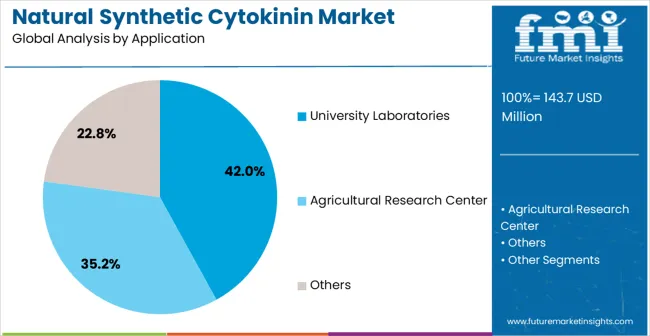
The university laboratories segment is expected to represent 42% of the natural synthetic cytokinin demand in 2025, reflecting the extensive use of cytokinin compounds in plant biology research conducted in academic institutions. University labs require high-quality cytokinin for a variety of research applications, such as plant development studies, tissue culture experiments, and agricultural biotechnology research. This segment benefits from increased research funding and the growing importance of plant science in addressing global challenges like food security and environmental responsibility. University laboratories prioritize cytokinin compounds that provide consistent biological activity and reproducible outcomes, essential for publication-quality research. With growing interdisciplinary research and expanding plant science curricula, university labs continue to drive consistent demand for high-quality cytokinin, supporting the growth of global research programs.
The natural synthetic cytokinin market is growing rapidly due to the increasing demand for crop yield improvement and the rising use of biostimulants in farming. Cytokinins like anti-zeatin riboside offer solutions for enhanced plant growth, stress resistance, and improved productivity. The market faces challenges such as high production costs, complex synthesis processes, and regulatory hurdles. These factors hinder widespread adoption and limit accessibility to certain market segments. To overcome these constraints, investment in efficient production technologies, cost-effective formulations, and regulatory compliance is essential for market growth and development.
The adoption of synthetic biology and advanced manufacturing techniques is driving the efficient production of high-purity anti-zeatin riboside. These approaches allow for enhanced production efficiency, reduced costs, and consistent product quality. Biosynthetic pathways are being developed to improve the scalability of cytokinin production while maintaining the required purity standards. Automated systems for purification and formulation are helping manufacturers optimize their production processes. These innovations not only address cost challenges but also improve regulatory compliance, ensuring the safe and consistent supply of high-quality cytokinin compounds for the agricultural sector.
Suppliers are increasingly focusing on developing specialized formulations of anti-zeatin riboside tailored to specific agricultural applications. This includes optimizing the compound’s stability, bioactivity, and effectiveness under varying environmental conditions. Advances in formulation science and stability-enhancement technologies are enabling the production of more durable and versatile cytokinin-based products. Packaging solutions designed to preserve the integrity of the compounds are becoming more prevalent, ensuring that products remain stable throughout their shelf life. These innovations are positioning cytokinin-based products as essential tools for modern agricultural and horticultural practices, offering targeted solutions for improving crop health and yield.
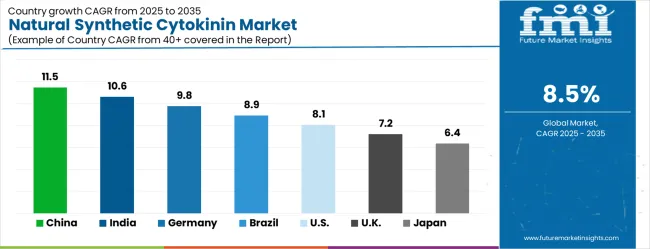
| Country | CAGR (2025–2035) |
|---|---|
| China | 11.5% |
| India | 10.6% |
| Germany | 9.8% |
| Brazil | 8.9% |
| United States | 8.1% |
| United Kingdom | 7.2% |
| Japan | 6.4% |
The natural synthetic cytokinin market is growing rapidly, with China leading at an 11.5% CAGR through 2035, driven by massive investment in agricultural biotechnology research, expanding university research programs, and growing demand for high-quality plant biology reagents. India follows at 10.6%, supported by increasing agricultural research initiatives and growing biotechnology sector development across academic and industrial research institutions. Germany records strong growth at 9.8%, emphasizing plant science research excellence, biotechnology innovation, and advanced agricultural research capabilities. Brazil grows steadily at 8.9%, integrating modern plant biotechnology research into agricultural development and crop improvement programs. The United States shows robust growth at 8.1%, focusing on agricultural biotechnology innovation and advanced plant science research. The United Kingdom maintains strong expansion at 7.2%, supported by plant biology research excellence and biotechnology development programs. Japan demonstrates significant growth at 6.4%, emphasizing precision biotechnology and advanced plant research applications.
The report covers an in-depth analysis of 40+ countries,with top-performing countries highlighted below.
The natural synthetic cytokinin market in China is projected to grow at a CAGR of 11.5% from 2025 to 2035. The growing demand for high-yield crops, particularly rice, wheat, and corn, is driving the use of anti-zeatin riboside in agriculture. As the largest producer and consumer of agricultural chemicals. The agricultural policies are increasingly integrating cytokinin-based solutions into crop management practices. The rapid adoption of precision farming technologies is also expanding the scope of synthetic cytokinin, with farmers turning to these plant growth regulators to increase yield, improve resistance to environmental stress, and extend shelf life. Research institutions and agricultural universities are developing novel applications in combination with other growth regulators, further fueling market growth. The widespread use of cytokinin-based products in horticulture and fruit farming is expected to accelerate demand. China is witnessing a rise in domestic production of cytokinin compounds, which further strengthens its market position.
The natural synthetic cytokinin market in India is expected to grow at a CAGR of 10.6% through 2035, driven by the need to enhance crop productivity and quality. As the second-largest agricultural producer globally, the agricultural sector is a key consumer of plant growth regulators. The Indian government’s push towards improving agricultural efficiency and reducing crop losses during adverse weather events is expected to increase demand for synthetic cytokinins, which enhance plant resistance to drought and diseases. Major crops such as wheat, rice, and pulses benefit from cytokinin use, and emerging horticultural sectors like fruits and vegetables are adopting these solutions. The increase in greenhouse farming and high-tech agriculture solutions will further support market growth. The increasing awareness of the importance of plant growth regulators among Indian farmers, along with government initiatives to provide subsidies for agrochemical products, is expected to drive product adoption.
Sales for natural synthetic cytokinin in Germany are growing at a CAGR of 9.8% from 2025 to 2035. As a leader in agricultural research and development, Germany is witnessing significant demand for anti-zeatin riboside in both commercial and organic farming sectors. The focus on longevity and precision agriculture techniques is leading to greater use of plant growth regulators to optimize yield and ensure better crop resilience to climatic challenges. Germany’s position as a hub for agricultural biotechnology innovation drives demand for advanced cytokinin products. The strong focus on reducing pesticide use while improving food security is another factor boosting demand. High-value horticulture crops such as fruits and vegetables are increasingly incorporating cytokinin-based solutions to improve fruit size and quality.
The natural synthetic cytokinin market in Brazil is anticipated to grow at a CAGR of 8.9% during the 2025–2035 period. The large agricultural base, particularly in crops like soybeans, sugarcane, and coffee, presents a significant opportunity for cytokinin products. Brazil is a major exporter of agricultural products, and the use of cytokinin to enhance crop productivity and disease resistance is increasingly critical. The market benefits from the government support for agricultural innovation and research, as well as a growing adoption of biotechnological farming practices. The trend of increasing mechanization and the use of agricultural drones for precision farming is also positively impacting cytokinin use. The dynamic agricultural sector and increasing demand for higher-yielding, disease-resistant crops position it as a significant market for synthetic cytokinin products.
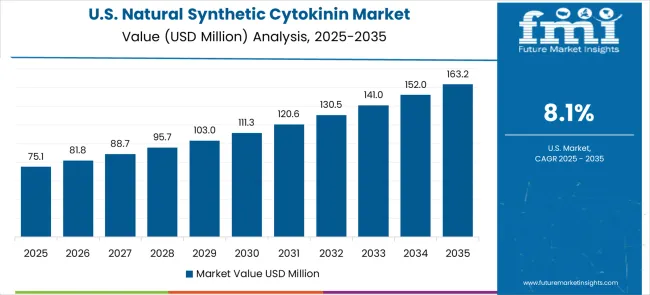
The USA market for natural synthetic cytokinin is projected to expand at a CAGR of 8.1% from 2025 to 2035. As the world’s largest agricultural producer, the United States sees significant use of anti-zeatin riboside in large-scale farming, particularly in crops such as corn, soybeans, and cotton. The focus on biotechnology and genetically modified crops has led to the increased use of cytokinin as part of integrated pest and disease management programs. With the expansion of organic farming practices, the demand for plant growth regulators that can help reduce reliance on chemical fertilizers and pesticides is also rising. Advancements in climate-resilient crop production are increasing the adoption of cytokinin-based products to improve crop yield and quality under varying environmental conditions.
The United Kingdom’s market for natural synthetic cytokinin is expected to grow at a CAGR of 7.2% from 2025 to 2035. As an early adopter of green farming practices, the UK is increasingly turning to cytokinin products to improve crop resilience, yield, and quality. The demand is driven by the need to optimize food production while minimizing environmental impact. The use of plant growth regulators like anti-zeatin riboside is rising in commercial agriculture and horticulture, especially for crops such as tomatoes, lettuce, and other vegetables. The UK government’s support for agricultural innovation and eco-friendly farming practices, along with the rise of urban farming, will likely boost market growth. The increased demand for high-quality, pesticide-free produce in the consumer market is encouraging the use of cytokinin-based products.
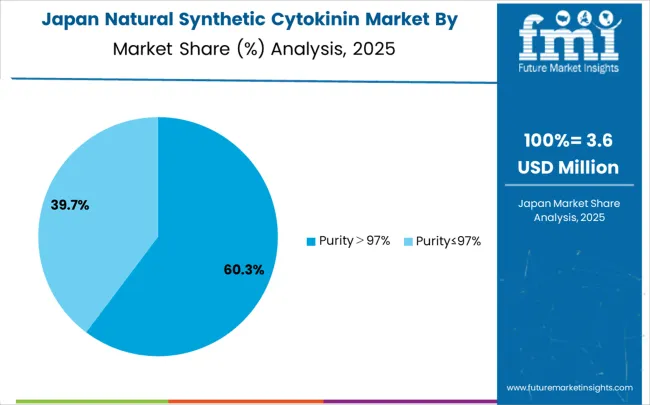
Demand for natural synthetic cytokinin in Japan is expanding at a CAGR of 6.4% from 2025 to 2035, driven by the advanced agricultural technologies and the adoption of plant growth regulators. The Japanese government’s initiatives to modernize the agricultural sector, particularly in rice, vegetables, and fruit farming, are expected to create significant growth opportunities. Japan’s focus on high-quality, genetically modified crops to withstand environmental stress is boosting demand for anti-zeatin riboside. In addition, the increasing trend of vertical farming and controlled-environment agriculture is pushing for the adoption of growth regulators. The need to enhance crop yield while minimizing the use of chemical fertilizers and pesticides is a significant driver.
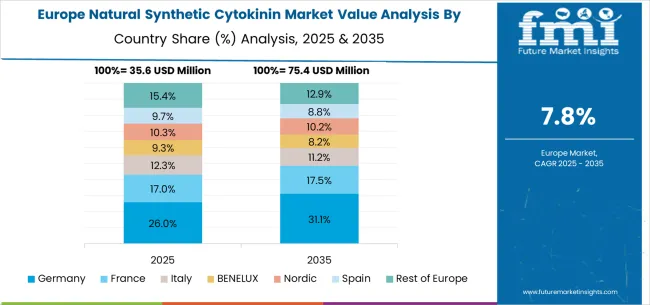
The natural synthetic cytokinin (anti-zeatin riboside) market in Europe is projected to grow from USD 35.6 million in 2025 to USD 75.4 million by 2035, registering a CAGR of 7.8% over the forecast period. Germany will lead the market, expanding from 26.0% in 2025 to 31.1% by 2035, supported by its strong plant science research base, agricultural biotechnology programs, and advanced biotech infrastructure. France will hold 17.0% in 2025, rising to 17.5% by 2035, benefiting from agricultural research and crop protection innovation. Italy is projected to contribute 12.9% in 2025, declining to 12.0% by 2035, reflecting stable but maturing agricultural biotechnology demand.
The BENELUX region will account for 9.3% in 2025, easing to 8.2% by 2035, reflecting market consolidation in agricultural biotech hubs. The Nordic countries will capture 9.7% in 2025, declining to 8.8% by 2035, supported by sustainable agriculture and biotech adoption but facing slower incremental growth. Spain is forecast to represent 9.7% in 2025, declining to 8.8% by 2035, reflecting moderate adoption in crop biotechnology. Meanwhile, the Rest of Europe will decrease from 15.4% in 2025 to 12.9% by 2035, as adoption in Eastern Europe lags behind leading Western agricultural research hubs.
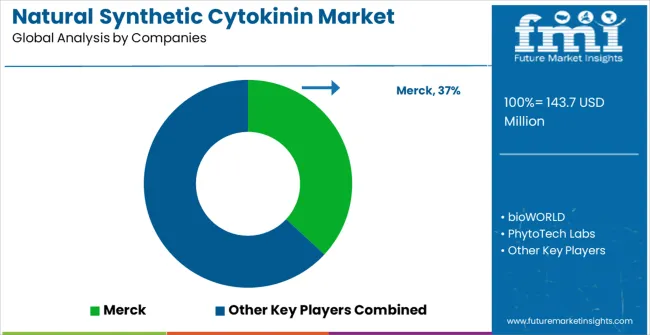
The natural synthetic cytokinin market is defined by competition among established biochemical suppliers, specialized plant biology reagent companies, and regional research chemical providers. Companies are investing in advanced synthesis technologies, purification systems, quality assurance programs, and comprehensive technical support services to deliver reliable, high-purity, and scientifically validated cytokinin compounds. Strategic partnerships, research collaboration, and geographic expansion are central to strengthening product portfolios and scientific community relationships.
Merck, operating globally, offers comprehensive biochemical reagent solutions with focus on research quality, product reliability, and scientific support services. bioWORLD provides specialized plant biology reagents with focus on cytokinin compounds and plant growth regulator applications. PhytoTech Labs delivers comprehensive plant tissue culture and research reagents with focus on plant biology applications. Gold Biotechnology®, Inc. offers research-grade biochemicals with proven applications in plant science research.
TCI provides high-purity chemical compounds with focus on research applications and quality assurance. Carl ROTH delivers laboratory chemicals and reagents with comprehensive quality documentation. Thermo Scientific Chemicals offers research-grade biochemicals with global distribution and technical support. Genaxxon provides specialized research reagents with focus on life science applications.
Cayman Chemical, Santa Cruz Biotechnology, MedChemExpress, Agrisera AB, Biomol GmbH, Phygenera, Yeasen, and Leagene offer specialized biochemical expertise, comprehensive product portfolios, and technical support across global and regional research communities.
The natural synthetic cytokinin market underpins plant biology research advancement, agricultural biotechnology development, eco-friendly agriculture innovation, and food security solutions. With research quality requirements, scientific rigor standards, and demand for reproducible research outcomes, the sector must balance product innovation, quality assurance, and accessibility. Coordinated contributions from governments, research institutions, manufacturers, agricultural organizations, and investors will accelerate the transition toward advanced, resource-efficient , and scientifically validated plant research technologies.
| Items | Values |
|---|---|
| Quantitative Units | USD 143.7 million |
| Classification Type | Purity >97%, Purity ≤97% |
| Application | University Laboratories, Agricultural Research Center, Others |
| Regions Covered | North America, Europe, East Asia, South Asia & Pacific, Latin America, Middle East & Africa |
| Country Covered | United States, Germany, India, China, United Kingdom, Japan, Brazil, and other 40+ countries |
| Key Companies Profiled | Merck, bioWORLD, PhytoTech Labs, Gold Biotechnology®, Inc., TCI, Carl ROTH, Thermo Scientific Chemicals, Genaxxon, Cayman Chemical, Santa Cruz Biotechnology, MedChemExpress, Agrisera AB, Biomol GmbH, Phygenera, Yeasen, Leagene |
| Additional Attributes | Dollar sales vary by purity and application; regional demand (NA, EU, APAC); competition among suppliers; buyers prioritize purity; biotech integration, synthesis innovations, and adoption of stable specialized formulations for plant research. |
The global natural synthetic cytokinin (anti-zeatin riboside) market is estimated to be valued at USD 143.7 million in 2025.
The market size for the natural synthetic cytokinin (anti-zeatin riboside) market is projected to reach USD 324.9 million by 2035.
The natural synthetic cytokinin (anti-zeatin riboside) market is expected to grow at a 8.5% CAGR between 2025 and 2035.
The key product types in natural synthetic cytokinin (anti-zeatin riboside) market are purity>97% and purity≤97%.
In terms of application, university laboratories segment to command 42.0% share in the natural synthetic cytokinin (anti-zeatin riboside) market in 2025.






Our Research Products

The "Full Research Suite" delivers actionable market intel, deep dives on markets or technologies, so clients act faster, cut risk, and unlock growth.

The Leaderboard benchmarks and ranks top vendors, classifying them as Established Leaders, Leading Challengers, or Disruptors & Challengers.

Locates where complements amplify value and substitutes erode it, forecasting net impact by horizon

We deliver granular, decision-grade intel: market sizing, 5-year forecasts, pricing, adoption, usage, revenue, and operational KPIs—plus competitor tracking, regulation, and value chains—across 60 countries broadly.

Spot the shifts before they hit your P&L. We track inflection points, adoption curves, pricing moves, and ecosystem plays to show where demand is heading, why it is changing, and what to do next across high-growth markets and disruptive tech

Real-time reads of user behavior. We track shifting priorities, perceptions of today’s and next-gen services, and provider experience, then pace how fast tech moves from trial to adoption, blending buyer, consumer, and channel inputs with social signals (#WhySwitch, #UX).

Partner with our analyst team to build a custom report designed around your business priorities. From analysing market trends to assessing competitors or crafting bespoke datasets, we tailor insights to your needs.
Supplier Intelligence
Discovery & Profiling
Capacity & Footprint
Performance & Risk
Compliance & Governance
Commercial Readiness
Who Supplies Whom
Scorecards & Shortlists
Playbooks & Docs
Category Intelligence
Definition & Scope
Demand & Use Cases
Cost Drivers
Market Structure
Supply Chain Map
Trade & Policy
Operating Norms
Deliverables
Buyer Intelligence
Account Basics
Spend & Scope
Procurement Model
Vendor Requirements
Terms & Policies
Entry Strategy
Pain Points & Triggers
Outputs
Pricing Analysis
Benchmarks
Trends
Should-Cost
Indexation
Landed Cost
Commercial Terms
Deliverables
Brand Analysis
Positioning & Value Prop
Share & Presence
Customer Evidence
Go-to-Market
Digital & Reputation
Compliance & Trust
KPIs & Gaps
Outputs
Full Research Suite comprises of:
Market outlook & trends analysis
Interviews & case studies
Strategic recommendations
Vendor profiles & capabilities analysis
5-year forecasts
8 regions and 60+ country-level data splits
Market segment data splits
12 months of continuous data updates
DELIVERED AS:
PDF EXCEL ONLINE
Natural Refrigerant Chiller Market Size and Share Forecast Outlook 2025 to 2035
Natural Antioxidant Market Size and Share Forecast Outlook 2025 to 2035
Natural Disaster Detection IoT Market Forecast Outlook 2025 to 2035
Natural Cosmetic Color Market Size and Share Forecast Outlook 2025 to 2035
Natural Food Preservatives Market Size and Share Forecast Outlook 2025 to 2035
Natural Polymer Market Size and Share Forecast Outlook 2025 to 2035
Natural Gas Analyzers Market Size and Share Forecast Outlook 2025 to 2035
Natural Mineral Oil Coolant Market Size and Share Forecast Outlook 2025 to 2035
Natural Food Flavors Market Size and Share Forecast Outlook 2025 to 2035
Natural Silicone Alternative Market Analysis - Size and Share Forecast Outlook 2025 to 2035
Natural Skincare Preservatives Market Analysis - Size and Share Forecast Outlook 2025 to 2035
Natural Surfactant Market Size and Share Forecast Outlook 2025 to 2035
Natural Bitterness Blockers Market Analysis - Size And Share Forecast Outlook 2025 To 2035
Naturally Fermented Food Market Size and Share Forecast Outlook 2025 to 2035
Natural Refrigerants Market Size and Share Forecast Outlook 2025 to 2035
Natural Ferulic Acid Market Size and Share Forecast Outlook 2025 to 2035
Natural Vitamin E Product Market Size and Share Forecast Outlook 2025 to 2035
Natural Oil Polyols NOP Market Size and Share Forecast Outlook 2025 to 2035
Natural Rubber Market Size and Share Forecast Outlook 2025 to 2035
Natural Language Processing in Finance Market Size and Share Forecast Outlook 2025 to 2035

Thank you!
You will receive an email from our Business Development Manager. Please be sure to check your SPAM/JUNK folder too.
Chat With
MaRIA